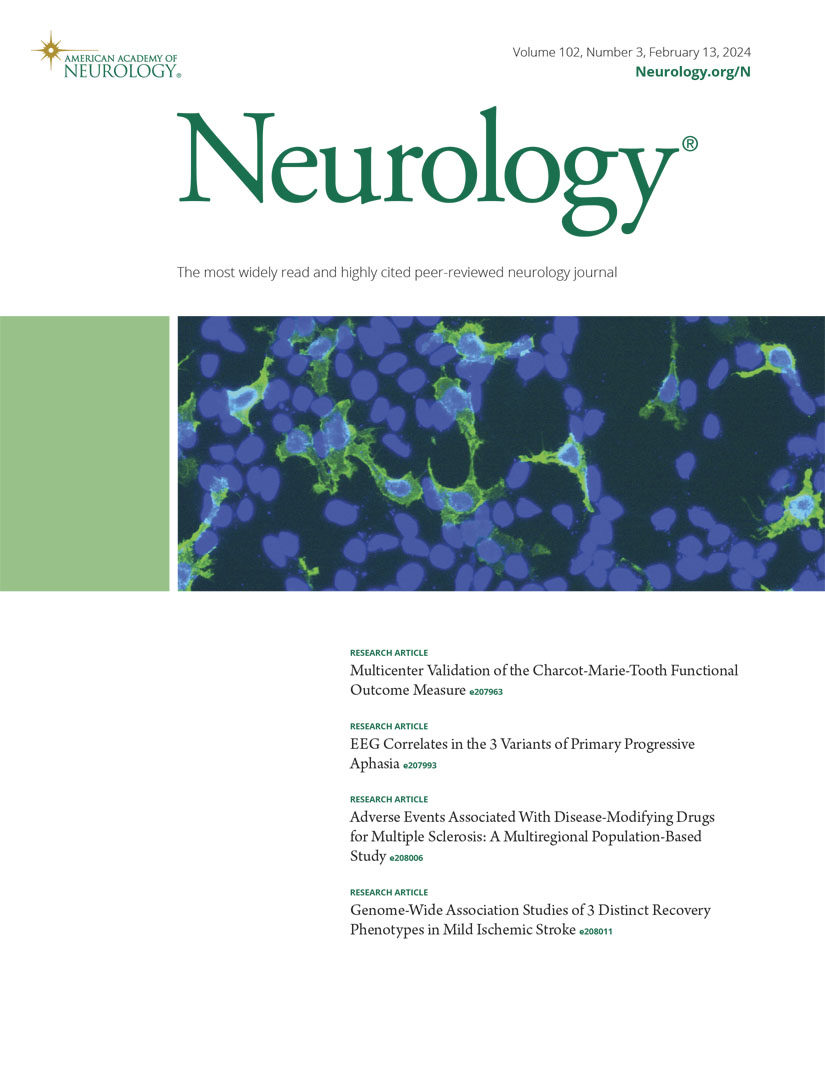GLP-1RA-Associated Diabetic Lumbosacral Radiculoplexus and Common Fibular Neuropathies: A Case-Control Evaluation.
IF 7.7
1区 医学
Q1 CLINICAL NEUROLOGY
引用次数: 0
Abstract
BACKGROUND AND OBJECTIVES Glucagon-like peptide-1 receptor agonists (GLP-1RAs) are increasingly used to treat obesity and diabetes. Semaglutide, a GLP-1RA, is linked to nonarteritic ischemic optic neuropathy (NAION), macular edema, and retinopathy. Because diabetic lumbosacral radiculoplexus neuropathy (DLRPN) and common fibular neuropathy (CFN) are associated with weight loss, we examined whether GLP-1RA usage is linked to these neuropathies. METHODS We conducted a retrospective case-controlled study from April 28, 2005 (the first GLP-1RA Food and Drug Administration approval), to December 25, 2024. Patients diagnosed with DLRPN or CFN were analyzed for GLP-1RA exposure and clinical characteristics. A control group, matched for age, sex, body mass index (BMI), and diabetes status, was used to assess for an association with GLP-1RA use. RESULTS We identified 26 individuals who developed 27 DLRPN episodes, with median symptom onset 6 months (range 3-35 months) after GLP-1RA initiation. At onset, they had a median glycated hemoglobin A1c (HbA1c) reduction of 2.4% (range 1%-8.5%) and a BMI decrease of 4 units (range 1-15), reflecting a 13.9% (range 3.6%-28.5%) weight loss. Microvasculitis was present in 4 of 5 nerve biopsies. Among 77 individuals with CFN, 82 episodes developed, with a mean GLP-1RA duration of 15 months (range 1-112 months). In individuals with CFN, the median HbA1c reduction was 1.2% (range -0.4% to 5%) and the BMI decrease was 4 units (range 0-15), corresponding to a 15.7% (range 3.0%-37.0%) weight loss. Patients with DLRPN experienced greater HbA1c reductions than patients with CFN (2.4% vs 1.2%, p < 0.001). New NAION, macular edema, or retinopathy were not seen with episodes. Compared with controls, GLP-1RA users were 51% more likely to develop DLRPN (odds ratio [OR] 1.5, 95% CI 1.2-1.9, p = 0.0008) and 30% more likely to develop CFN (OR 1.3, 95% CI 1.0-1.5, p = 0.018). All episodes occurred after 2015, with 3 DLRPN events and 7 CFN events occurring between 2015 and 2019, rising to 24 and 70 cases in 2020-2024, reflecting increases of 700% and 900%. DISCUSSION GLP-1RA use is associated with an increased likelihood of DLRPN and CFN. DLRPN and its associated nerve microvasculitis seem more strongly linked to metabolic changes, particularly significant HbA1c reductions, while CFN has compressive neuropathy characteristics and is more influenced by weight loss.glp - 1ra相关糖尿病腰骶神经根丛和常见腓骨神经病变:病例-对照评估
背景与目的胰高血糖素样肽-1受体激动剂(GLP-1RAs)越来越多地用于治疗肥胖和糖尿病。Semaglutide是一种GLP-1RA,与非动脉性缺血性视神经病变(NAION)、黄斑水肿和视网膜病变有关。由于糖尿病腰骶神经根丛神经病变(DLRPN)和普通腓骨神经病变(CFN)与体重减轻有关,我们研究了GLP-1RA的使用是否与这些神经病变有关。方法本研究于2005年4月28日(GLP-1RA首次获fda批准)至2024年12月25日进行回顾性病例对照研究。分析诊断为DLRPN或CFN的患者GLP-1RA暴露和临床特征。对照组与年龄、性别、体重指数(BMI)和糖尿病状况相匹配,用于评估与GLP-1RA使用的关系。结果:我们确定了26例出现27次DLRPN发作的患者,中位症状发作时间为GLP-1RA起始治疗后6个月(范围3-35个月)。发病时,患者糖化血红蛋白(HbA1c)中位数降低2.4%(范围1%-8.5%),BMI降低4个单位(范围1-15),反映体重减轻13.9%(范围3.6%-28.5%)。5例神经活检中有4例出现微血管炎。77例CFN患者中,82例发作,平均GLP-1RA持续时间为15个月(范围1-112个月)。在CFN患者中,HbA1c降低的中位数为1.2%(范围为-0.4%至5%),BMI降低了4个单位(范围为0-15),相当于体重减轻了15.7%(范围为3.0%-37.0%)。DLRPN患者的HbA1c降低幅度大于CFN患者(2.4% vs 1.2%, p < 0.001)。新的NAION,黄斑水肿,或视网膜病变未见发作。与对照组相比,GLP-1RA使用者发生DLRPN的可能性增加51%(比值比[OR] 1.5, 95% CI 1.2-1.9, p = 0.0008),发生CFN的可能性增加30%(比值比[OR] 1.3, 95% CI 1.0-1.5, p = 0.018)。所有事件均发生在2015年之后,2015年至2019年期间发生了3例DLRPN事件和7例CFN事件,2020年至2024年分别上升至24例和70例,分别增加了700%和900%。lp - 1ra的使用与DLRPN和CFN的可能性增加有关。DLRPN及其相关的神经微血管炎似乎与代谢变化密切相关,尤其是显著的HbA1c降低,而CFN具有压缩性神经病特征,更受体重减轻的影响。
本文章由计算机程序翻译,如有差异,请以英文原文为准。
求助全文
约1分钟内获得全文
求助全文
来源期刊

Neurology
医学-临床神经学
CiteScore
12.20
自引率
4.00%
发文量
1973
审稿时长
2-3 weeks
期刊介绍:
Neurology, the official journal of the American Academy of Neurology, aspires to be the premier peer-reviewed journal for clinical neurology research. Its mission is to publish exceptional peer-reviewed original research articles, editorials, and reviews to improve patient care, education, clinical research, and professionalism in neurology.
As the leading clinical neurology journal worldwide, Neurology targets physicians specializing in nervous system diseases and conditions. It aims to advance the field by presenting new basic and clinical research that influences neurological practice. The journal is a leading source of cutting-edge, peer-reviewed information for the neurology community worldwide. Editorial content includes Research, Clinical/Scientific Notes, Views, Historical Neurology, NeuroImages, Humanities, Letters, and position papers from the American Academy of Neurology. The online version is considered the definitive version, encompassing all available content.
Neurology is indexed in prestigious databases such as MEDLINE/PubMed, Embase, Scopus, Biological Abstracts®, PsycINFO®, Current Contents®, Web of Science®, CrossRef, and Google Scholar.
 求助内容:
求助内容: 应助结果提醒方式:
应助结果提醒方式:


